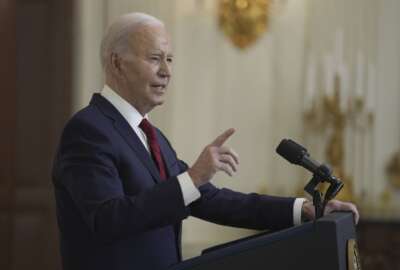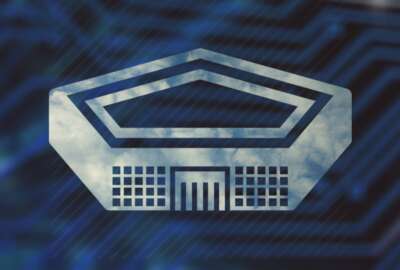DoD seeks to create ‘culture of learning’ through CDAO
Christopher Skaluba, the executive director in the DoD CDAO, said the office is creating tools to provide data-driven insights on AI workforce needs.
The Defense Department has a plan to drive data analytics and artificial intelligence into its day-to-day business and into warfighter functions.
But before that can happen, the Pentagon has to make sure its workforce, both civilian and service members, are prepared to use these tools.
That’s where the Chief Digital and Artificial Intelligence Office (CDAO) comes in.
Christopher Skaluba, the executive director in the DoD CDAO, said as the functional community manager for data analytics and AI workforce, his team is creating a standardized framework for identifying the skill sets the workforce needs today and in the future.
“We have a digital learning framework that enables staff to build data in a data analytics and AI knowledge at the foundational level, at intermediate levels and advanced levels for their specific roles in the department,” Skaluba said on Ask the CIO. “Then we’re doing a lot of outreach in local communities. So through academic and industry partnerships, we’re broadening students’ exposure to DoD career paths, and that’s in middle school, high schools and in colleges relative to data analytics and AI and how the department uses it. We hope that by engaging students of underrepresented communities, for instance, we’re expanding and diversifying the future workforce. Back into the department, we’re doing a lot of cross-functional collaboration, developing a centralized and trusted space to do collaboration, education on data analytics, professional development, and to have access to all this huge guidance to navigate the fields of data analytics and AI.”
The training, educating and development of the workforce is a key piece to the broader DoD AI strategy released last November. In that document, DoD called for creating an environment for defense leaders and personnel to effectively use AI, data and analytics. As part of that effort, the DoD plans to hire 2,500 AI experts this year, and the more than 9,000 new hires it plans on making next year.
While hiring new employees is one piece, Skaluba said upskilling and reskilling current employees is just as important.
“We’re creating tools and products that provide data-driven insights on AI workforce trends inside and outside of DoD. We want to identify where we have skill gaps across the department and align personnel with AI skills and areas of particular need,” he said. “Fundamentally, a significant part of this effort is about how we communicate the risks and the potential of data and AI to the broader department workforce. I want to emphasize the department’s military members or its civilians do not need to be part of an AI community or have years of experience in AI-related positions. What they need, we think, is a general awareness of how data and AI can work for them, things like the characteristics of data that make it a valuable resource, how analytics could give them new insights into their work and where they should and should not trust AI-enabled systems like large language models.”
Experimenting with AI
The CDAO has several efforts to upskill the workforce to ensure they can ask those questions about how best to take advantage of AI tools and capabilities.
Skaluba said all of these efforts fall under creating “a culture of learning and experimentation across the department.”
“We want the staff to experiment with use cases in responsible ways, and we want leaders who will be willing to change how they think about their organization’s data, how it’s structured, how they share it,” he said. “That is a significant piece of this alone is just changing the culture, and that’s not something CDAO can do. We can only set the foundation of that for the rest of the department.”
One way the CDAO is helping to set the foundation is through partnerships with several academic institutions to educate general and flag officers as well as members of the Senior Executive Service (SES).
Skaluba said this three-day course focuses on leading data in AI-enabled organizations.
“The course is meant to equip DoD leaders with data-driven strategies to help them learn how to consume data in AI solutions in a more informed manner and become champions of investment in the digital workforce and digital solutions,” he said. “I’ve had many colleagues around the department who’ve taken this course seek me out to say that was tremendous and really helpful to my day-to-day work. This is something we’re trying to scale. But then more broadly, we’re giving all DoD employees access to something we’re calling digital on demand, which is an online learning platform with a library of resources and self-paced courses on a range of data, AI and emerging technology topics.”
Addressing any fears of AI
Additionally, the CDAO is focused on ensuring employees at all levels across DoD have access to training and reskilling. Skaluba said the idea is convince not just the early adopters, but those who are suspect of AI and how it can help DoD meet mission goals.
He said the CDAO’s focus is on making sure they understand the personal and professional value that comes with learning to use AI capabilities as well as addressing any fears employees may have.
“We have a massive workforce in the department, so we want to make sure that all employees have educational tools and resources available to them. What we don’t want to do is make this a burden, add on a bunch of additional tasks to people who are already busy trying to do their day jobs,” Skaluba said. “Our approach to developing and refining our content on the digital on demand platform is shaped with an intent to make employees want to take advantage of it at any time, in in any place convenient to them, online, if they have 15 minutes here or there. If they want to do a little reading on a particular subject, it’s there for them. But I also think it’s important just generally to recognize that upskilling and reskilling, ensuring literacy at the department of these capabilities can happen at different paces and with different intensities for different communities of the department. So depending on your role, I think some communities need to adopt more quickly, and we’re making sure senior leader attention and resources are focused there. In other cases, we just have to methodically bring people along the journey.”
The fact for DoD is every employee needs to be brought along in this data analytics and AI journey. Skaluba said it becomes clearer every day of the role these tools and capabilities can and need to have in everything from back office functions to the tactical edge.
He said as the workforce skill sets expand and improve, they will recognize the real potential of AI.
“To me, kind of scaling understanding across the department this workforce by showing practical use cases and value that for people’s work is probably the key in this,” Skaluba said. “I think what I hear most from the workforce is, ‘hey, I have this particular set of problems and can I apply a digital tool or can I bring data together in a way to give me new insights?’ Sometimes those are very serious warfighting problems, where we’re trying to help our warfighters on the tactical edge do something that gives them an advantage in deterrence and defense of our nation. I think the CDAO’s work is both in terms of the policy making, making sure that people understand the framework that we’re working in, but also as a digital services provider, engaging as many parts of the department as we can, at every level, applying use cases where we can, and showing people that there’s real value here from digital solutions.”
Copyright © 2024 Federal News Network. All rights reserved. This website is not intended for users located within the European Economic Area.
Jason Miller is executive editor of Federal News Network and directs news coverage on the people, policy and programs of the federal government.
Follow @jmillerWFED








